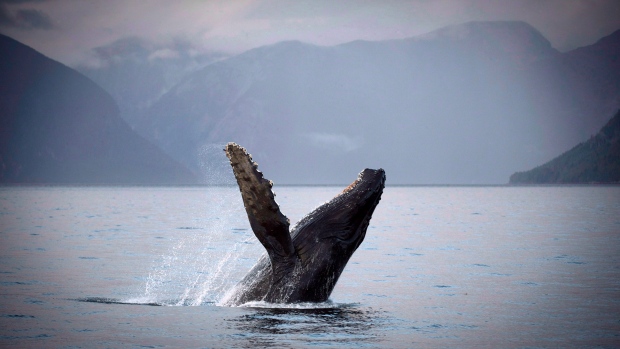
This article was last updated on April 16, 2022
Canada: ![]() Oye! Times readers Get FREE $30 to spend on Amazon, Walmart…
Oye! Times readers Get FREE $30 to spend on Amazon, Walmart…
USA: ![]() Oye! Times readers Get FREE $30 to spend on Amazon, Walmart…
Oye! Times readers Get FREE $30 to spend on Amazon, Walmart…

The federal government has announced to have downgraded the North Pacific humpback whale from its status of “threatened” species to “species of special concern” and hence removed a potentially significant legal hurdle out of the way of the multi-million-dollar Northern Gateway pipeline project. The humpback will consequently lose the protections it receives under Canada’s Species at Risk Act (SARA).
The decision was reveled in the latest edition of Canada Gazette and said that the reclassification means the North Pacific humpback “would no longer be subject to the general prohibitions set out in SARA, nor would its critical habitat be required to be legally protected under SARA. However, other provisions of SARA would continue to apply.” The decision was reached after a 2011 report by the Committee on the Status of Endangered Wildlife in Canada (COSEWIC), i.e. an independent board that advises the federal government on classifying Canada’s animal species. Consequently, the government issued 312 notices for public consultations regarding the potential change in the humpback’s status, out of which it received 22 responses.
According to the government, the 22 responses included four that were undecided, and five in favor of reclassifying the humpback and citied improving population numbers as justification. Whereas, thirteen respondents opposed the decision saying that “the general concern was that the prohibitions were a deterrent against industry harming the individuals.” Whereas, “some of the respondents indicated that the reclassification of the species could lead to increased activities in the waters along the British Columbia coast. These activities could result in increased tanker traffic, entanglements, and hazardous petroleum product spills.”

While the population of whales has increased since they were protected from hunting, it’s not clear how current populations compare to pre-hunting populations, says the CBC story on the whale status change.
This is known as a Changing Baseline. The following story headlined “Baseline shifts prove tough to read — Ecosystem changes can be attributed somewhat to public’s failure to notice” says it all.
By Andy Lee Roth May 10, 2013
How do we measure health? If we’re talking about a human being, then one measure of it is temperature. Fever, for example, can be a symptom of medical conditions including flu, mononucleosis or malaria. Concerned parents and medical professionals measure temperature with a thermometer and use 98.6 degrees Fahrenheit as a baseline.
Measuring the health of an ecosystem is much more difficult by comparison. If we define an ecosystem as a community of living and non-living things that work together, then what tools do we have to measure an ecosystem’s health, and what baselines do we use?
These questions matter to anyone interested in environmental protection. A determination of an ecosystem’s health or degradation depends on what baseline we use. Efforts to rehabilitate degraded ecosystems depend on some baseline, whether explicitly stated or tacitly understood, to define the end goal.
In the mcomment_ID-1990s, fishery biologists led by Dr. Daniel Pauly developed the concept of “shifting baselines” to describe changes over time in expectations about what constituted a healthy ecosystem. In simple terms, a shifting baseline means “failure to notice change.”
One original example of shifting baselines involved salmon populations in the Pacific Northwest’s Columbia River. In the 1990s, biologists determined the Columbia’s salmon population was twice as great as in the 1930s. This sounded like a tremendous success for efforts to restore the Columbia’s salmon. However, the 1990s population was only 10 percent of that found in the river during the 1800s.
When we lose track of earlier conditions – such as the 1800s salmon population – we are subject to a shifting baseline. When change occurs slowly, over a long period of time, we may not notice it. A few elders might say, “You should’ve seen it back in the old days,” but most people will lack direct experience with those earlier conditions. As Pauly stated in a 2010 TED Talk, “We transform the world, but we don’t remember it.”
Some animal species are abundant, like deer; others are rare, like California’s protected mountain lions. And still, other species have become extinct. Except in extraordinary cases, abundant species do not become extinct. It’s the rare species, or more accurately, the species that have become rare that face extinction.
This shapes our perceptions of extinction as a problem. We might be more concerned about an ecosystem’s health if abundant species became threatened with extinction. But, when only rare species face this ultimate threat, we often fail to recognize the significance of their loss as an indicator of the ecosystem’s health.